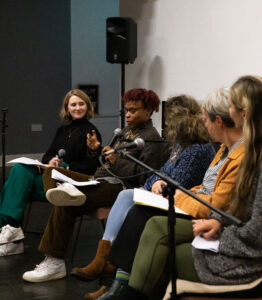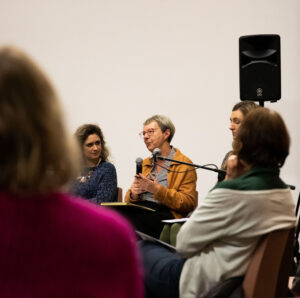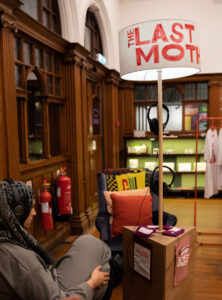The Last Taboo of Motherhood?: Reflections
Posted on: 1st February 2024
The Last Taboo of Motherhood? is a project that illuminates a historically overlooked area of women’s health: postnatal mental illness. Three audio plays by three writers, Courtney Conrad, Bryony Kimmings and Sara Shaarawi, use stories to shed light on this vital subject.
Each play draws on groundbreaking research led by Professor Hilary Marland, with Dr Kelly Couzens and Dr Fabiola Creed, informed by a variety of historical sources, including first hand testimonies from and by women in twentieth-century Britain.
The plays toured theatres, arts centres and libraries in the UK as part of an installation in 2023-2024, and are now available to listen to for FREE on Fuel Digital.
Courtney Conrad, Dr Fabiola Creed, and Dr Kelly Couzens reflect here on the process behind the project, and their hopes for audiences.
Courtney Conrad
When working with researchers, I found immense value in engaging in profound discussions, not only about the research itself but also on a personal level which added a deeper layer of vulnerability to the project.
With audio work, there is a deeper level of intimacy knowing that your voice is quite literally in the ear of a stranger, the attentiveness to your breath, tone, the musicality of language. I loved the challenge it posed for me to be highly intentional with each word selection, tone, pronunciation etc.
There are several things I hope audiences take away from MI DI ONCE BAWL FI DI BELLY WEH MI WAH DASH WEH NOW?
Destigmatisation: I hope this recording provokes conversations among parents and children, partners, and friends that are vulnerable and not judgemental. Validation of emotions: I hope women who can identify with these experiences feel seen, heard and respected. Reflection on societal expectations: I hope to contribute to a push towards challenging conventional notions of the idealized, perfect mother and encouraging a more realistic and compassionate view of the varied experiences that come with parenthood. Artistic expression as catharsis: I hope for people to be inspired to write their own experiences, even if they don’t share it with anyone else.

Prof Hilary Marland, Dr Fabiola Creed and Dr Kelly Couzens
Why is it important to explore this subject matter?
HM: Large numbers of women have experienced maternal mental illness throughout the twentieth century. Yet these experiences are often lost and, in many cases, unacknowledged. Our project aims to unearth these experiences, via historical sources such as medical and court records and through the voices of women themselves.
FC: Exploring the history of maternal mental illness is important because it illustrates what issues have remained relatively the same in the last century (e.g. differences in public responses based on intersectional differences, alongside harmful silencing and stigma, and difficulties accessing support). Improving people’s understanding of these issues, and why and how they continue, will raise both awareness and empathy to support others.
KC: The NHS estimates that at least one woman in every ten will experience postnatal depression in the first year after giving birth. Recent studies suggest that number is likely to be a significant underestimate. Although rare, some women also suffer from postpartum psychosis after giving birth. Given pregnancy, childbirth and new motherhood are often expected to be such happy times, it can be so much harder to acknowledge that these life changing events can also come with frightening and traumatic experiences for some women too. It is important to recognize this, as it is only by sharing these experiences and bringing these issues into public conversation that we can generate more positive outcomes for those women, and their families, impacted by maternal mental illnesses.

What do you think is the value of researchers collaborating with artists?
HM: Artists enable us to communicate our research in new, challenging and engaging ways, amplifying the voices of women in the past who have experienced maternal mental illness and others who have been affected by their suffering. While few people will ever read our academic outputs on the subject, listening to the audio pieces produced by the three artists on The Last Taboo of Motherhood? opens up our work to new audiences, stimulating refection, conversations and debate.
FC: Collaborating with artists helps you to see how other people interpret and use the historical sources you’ve analysed yourself. As a historian, you often have to appear more ‘objective’ and less emotional when publishing articles, yet artists do not have such constraints and, using their creative license, they can better capture the raw emotions that you often read and hear in women’s narratives and lived experiences of maternal mental illness.
KC: Collaborations with artists can enable us to have challenging conversations around issues that impact us in our own time by bridging the gap between the past and the present. This can also lead to new perspectives and interpretations on the past that have empathy and emotion at their core.

What do you hope audiences take away from this project?
HM: Our ambition is to invite people not only to think about issues surrounding maternal mental illness in the past and present but also to consider how we as a society address them. Our hope is that people discover the ways the past and present are connected, and that history can provide context and insights into how mental illness around childbirth is understood and responded to today.
FC: Each audio piece offers something different to take away from the project. Bryony Kimmings’ piece demonstrates the inter-generational tensions and challenges between daughters, mothers, grandmothers and so forth, and how it can be difficult to put yourself in someone else’s shoes until you experience something similar yourself. It also highlights how the romanticisation of child-rearing can be harmful for many mothers.
Courtney Conrad’s piece vividly captures how migrant mothers experience racism throughout their childbirth process in Britain. It also illustrates how women can experience a disassociation or disconnection from their identity when they give birth, and, albeit rare, postpartum psychosis. The piece concludes with a man’s voice, in this case, the husband and father, which is also important to consider when people experience maternal mental illness.
Sara Sharaawi’s piece raised questions about whose responsibility it is to support a mother suffering from maternal mental illness. The phrase ‘it takes a village to raise a child’ is there for a reason, and both judgment and gossiping can be extremely damaging.
KC: If audiences come away from this project wanting to talk about what they have just heard and to reflect on whether these stories resonate with the experiences or memories they themselves (or someone they know) may have had, then that is a great achievement. Hopefully by encouraging reflection and debate through these pieces, there will be more open and productive conversations around contemporary experiences of postnatal depression or psychosis that in the longer-term lead to improved provision of mental health care and support for sufferers and their families.